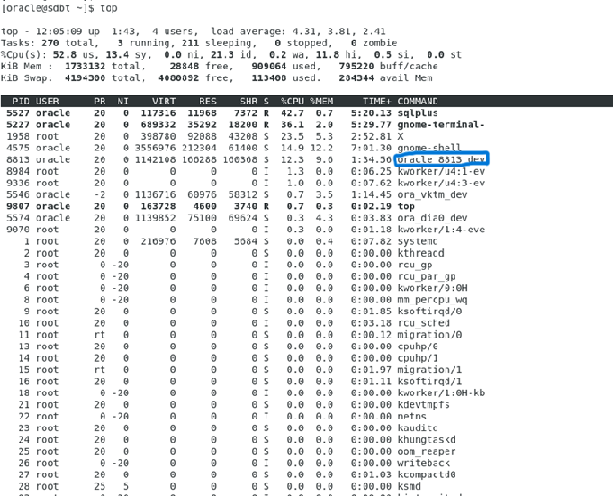Oracle Tuning - Kill Long running SessionsIdentifying Long-Running Sessions : There are several methods to identify long-running sessions in Oracle:
WE TAKE THREE TERMINAL
STEP 1 : Create Two Tables & Add Values :
create table tesdb1(id int,name varchar2(20));
create table tesdb2(id int,name varchar2(20));
begin
for i in 1 .. 10000 loop
insert into tesdb1 values(i,i);
end loop;
commit;
end;
/
PL/SQL procedure successfully completed.
begin
for i in 1..10000 loop
insert into tesdb2 values(i,i);
end loop;
commit;
end;
/
SQL> commit;
Commit complete.
SQL> select count(*) from tesdb1;
COUNT(*)
----------
10000
SQL> select count(*) from tesdb2;
COUNT(*)
----------
10000
STEP 2 : Select The Table Using Join :
SQL> select a.name,b.name from tesdb1 a inner join tesdb2 b on a.id<>b.id;
Open another terminal check the top commandTop 
SQL> select addr from v$process where spid=8813;
ADDR
----------------
0000000065D653B8
SQL> select sql_id from v$session where paddr='0000000065D653B8';
SQL_ID
-------------
131n5bxcwmkgp
SQL> select sql_text from v$sql where sql_id='131n5bxcwmkgp';
SQL_TEXT
--------------------------------------------------------------------------------
select a.name,b.name from tesdb1 a inner join tesdb2 b on a.id<>b.id
SQL> SELECT sid, serial#, sql_id, status from v$session where sql_id='131n5bxcwmkgp';
SID SERIAL# SQL_ID STATUS
---------- ---------- ------------- --------
237 31657 131n5bxcwmkgp INACTIVE
Kill the Session : Once you have identified the session to be terminated, use the ALTER SYSTEM KILL SESSION statement. Replace sid and serial# with the values from the identified session.
SQL> ALTER SYSTEM KILL SESSION '237,31657';
System altered.
SQL>
The following error will come in first terminal : ERROR: ORA-00028: your session has been killed 27848235 rows selected. Verify Termination : After executing the ALTER SYSTEM KILL SESSION statement, you can check whether the session has been successfully terminated by querying the v$session view. « Previous Next Topic » (Oracle Tuning - Improve performance on DMLs) |
